Figure 7. I-V and G-V relationships of HERG double-deletion mutants.

A, family of current traces recorded from HERG N-terminal deletion and N- and C-terminal double-deletion mutants with different test potentials. Outward currents were recorded in response to a voltage protocol in which commands were given from −80 to +70 mV for 1 s in steps of 10 mV from a holding potential of −80 mV; repolarization to −100 mV elicited inward tail currents. B, I-V relationships indicate that two double-deletion mutants, HERGNΔ354CΔ236 and HERGNΔ354CΔ278, had larger outward currents than WT channels (n = 16, P = 0.000003 for HERGNΔ354CΔ236 and HERGNΔ354CΔ278, and P = 0.000001 for the others). C, G-V relationships indicate that deletion of residues from the N-terminus and both the N- and C-termini of HERG shifted the activation to more positive voltages (n = 13, F= 0.747, P = 0.6). Slope (mV, mean ±s.e.m.) and V1/2 (mV, mean ±s.e.m.) values were 10.1 ± 0.7, −33.9 ± 0.8 for WT HERG; 16.1 ± 2.5, −22.1 ± 2.4 for HERGNΔ12CΔ236; 17.0 ± 1.7, +2.6 ± 1.7 for HERGNΔ354CΔ236; 16.5 ± 1.9, −11.6 ± 1.9 for HERGNΔ12CΔ278; 36.4 ± 10.7, −2.6 ± 7 for HERGNΔ354CΔ278; 26.7 ± 4.8, −5.9 ± 3.9 for HERGNΔ12; and 13.3 ± 2.7, −26 ± 3 for HERGNΔ354.
